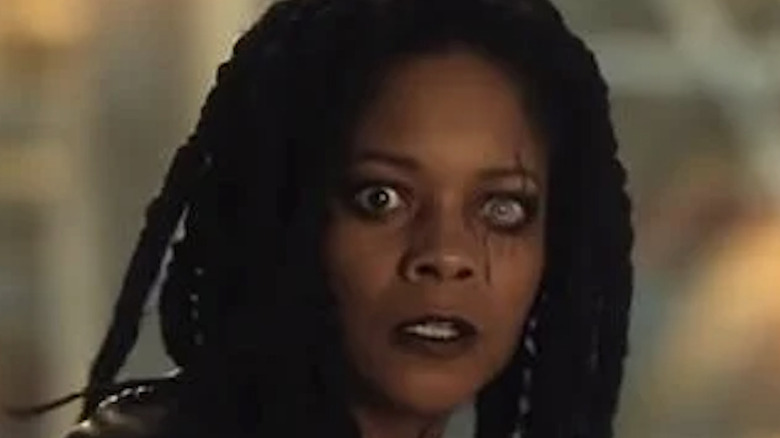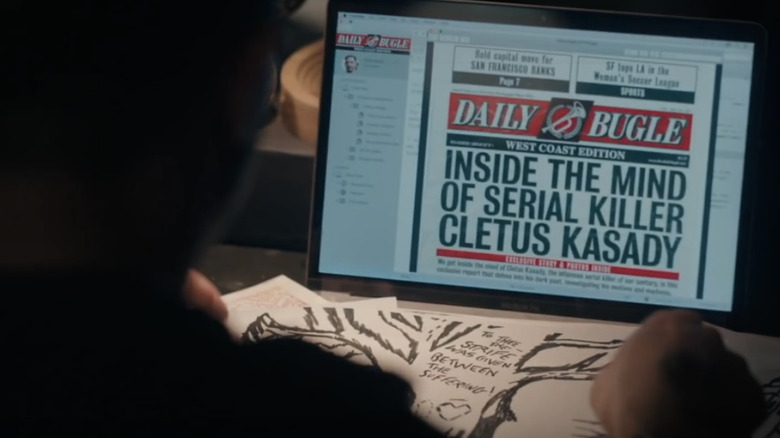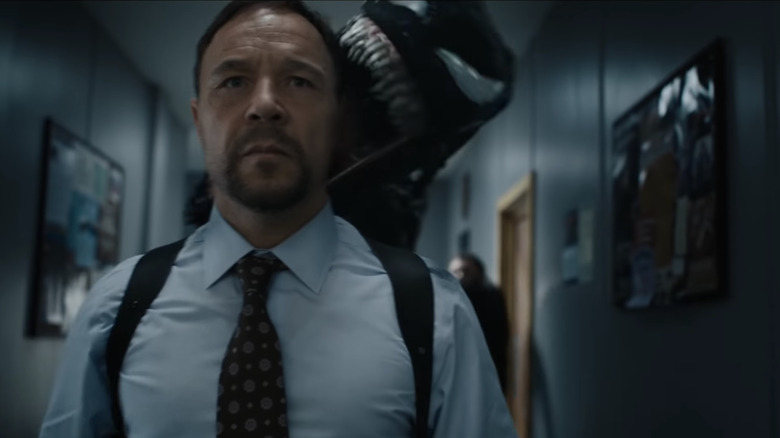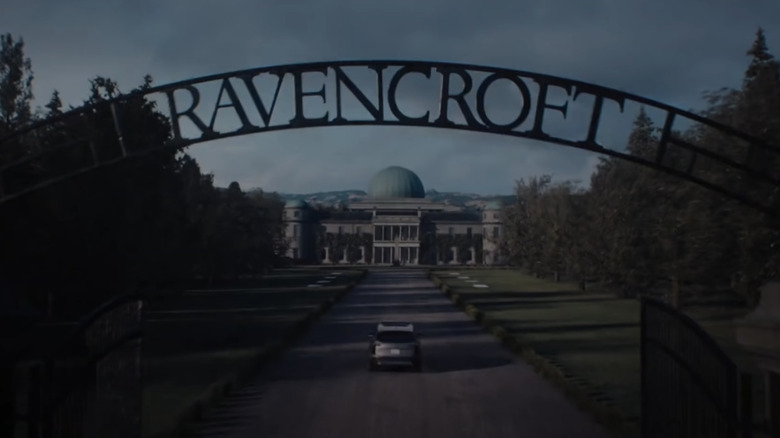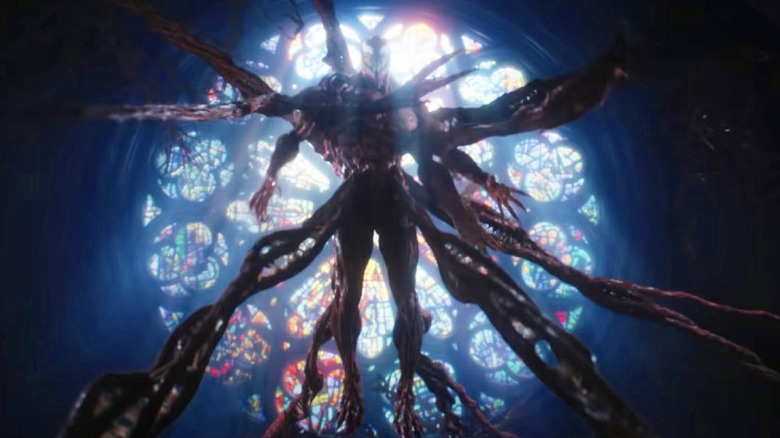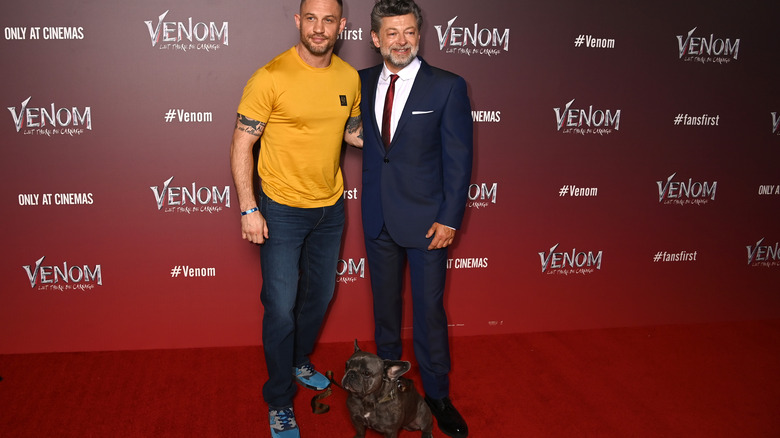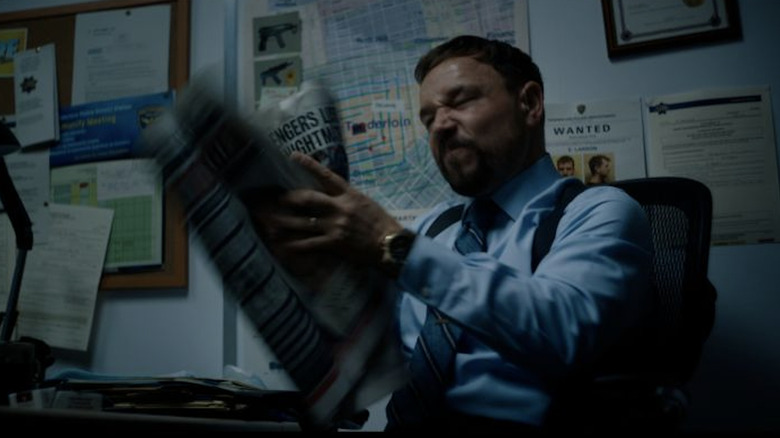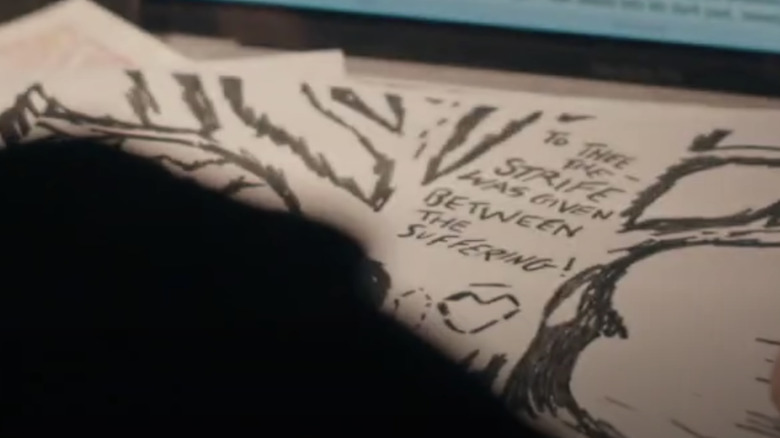Easter Eggs You Missed In Venom: Let There Be Carnage
Maybe you're a huge fan of the MCU. Maybe you're a fan of the "Venom" movies. Perhaps you're looking forward to "Morbius," or "Spider-Man: No Way Home," or the imminent explosion of the multiverse. Or — imagine this — perhaps be you just want to watch a fun, self-contained movie.
If any of the above descriptions fit you, then you'll be greeting "Venom: Let There Be Carnage" with a smile on your face and two eyes peeled for Easter eggs. After all, comic book fans, often trained from childhood by bright, vivid splash pages filled with subtle references to other characters, storylines and franchises, are uniquely equipped for this kind of hunt.
"Carnage" won't let you down. Although the film tells the self-contained story of Cletus Kasady and Frances "Shriek" Barrison escaping from their prisons, going on a Bonnie-and-Clyde-like mission to wed while wreaking as much havoc as possible and learning to wield the immense power of the symbiote Carnage, it also features eggs that will likely impact all the films mentioned above.
But there's no reason to feel intimidated, like Venom staring down a "red one." Below is a handy-dandy guide to the Easter eggs, winks, and nods throughout the Andy Serkis-directed, off-the-wall "Venom" sequel. Keep in mind that spoilers will be coming at you with more ferocity than a dieting symbiote spotting a chicken, and read on for all the info you need.
Fake news
For a journalist, Eddie Brock sure seems to keep his information sources limited; nearly every time Eddie is seen surfing the web, he's on the Daily Bugle website. Shriek and Detective Patrick Mulligan (Stephen Graham), meanwhile, share the same sourcing but seem to be more old school in their appreciation of getting newspaper ink on their fingertips. Also worth noting: These San Francisco-based characters are reading the "West Coast Edition" of what is apparently a nationwide newspaper, published in NYC.
For those who have never picked up a Spider-Man comic, the Daily Bugle has been around since "Marvel Mystery Comics" No. 18 way back in 1941, and served as the location for Peter Parker's first day job starting with the second issue of "The Amazing Spider-Man," published in 1963.
As with Clark Kent/Superman at DC's Daily Planet, in recent years the whole secret-identity-as-a-newspaper-employee thing has become a bit old-fashioned, so these news outlets have been reimagined in comic pages and onscreen as websites, TV channels, even podcasts. The latest "Daily Bugle" depiction is headed by a much-more-visible J. Jonah Jameson, seemingly reimagined as a Glenn Beck/Tucker Carlson/Sean Hannity angry news program host and less like the behind-the-desk editor-in-chief of old. One thing hasn't changed, however: he still thinks Spider-Man is a menace.
Which brings us to the mid-credits scene in "Carnage," when Eddie and Venom find themselves in a hotel room, watching a Jameson rant on TV where he reveals Spider-Man's secret identity. As we've seen from the "No Way Home" trailer, this moment comes right after the events of 2019's "Spider-Man: Far from Home" (which delighted fans with the revelation at the end that J.K. Simmons, aka Jameson in the Sam Raimi/Tobey Maguire films, would be returning to the role), and sets off the multiverse-bending plot machinations of the third Tom Holland Spidey film.
More importantly for the immediate future of the MCU, Jameson's "reporting" also seems to turn Venom's attention to Peter Parker. Also worth noting: Eddie Brock's byline is now being printed by the West Coast Bugle, and the masthead looks exactly like it did in the Sam Raimi movies. In other words, get yourself ready for a crossover that could finally bring symbiotes into the MCU.
Feeling blue
Early in the movie, when comics fans catch a glimpse of the name badge on the cop who shoots Shriek (Naomie Harris), they might get excited. And with good reason, because in the Venom/Carnage comics, Detective Patrick Mulligan is the New York City cop whose life is turned upside down when Carnage passes the next generation of symbiotes, a nasty creature known as Toxin, along to him.
"I'm a decent guy. Used to be a cop. Now I've got a crazy symbiote using me as a host," he says at one point in the comics. "However hard I try to educate it, whatever I do to bring it up properly, it misbehaves. And it brings out the worst in me. It's destroying me. What do I do? What's the answer?"
Unfortunately, in the comics Mulligan never really seems to find it. The officer tries to teach Toxin right from wrong, attempts to help heroes like Spider-Man and the Avengers, and even gets some slack from Venom, who hopes its quasi-grandchild will use its powers for good. But Pat is ultimately killed by Blackheart, and his symbiote then goes off to have more dark adventures with other hosts.
While we know that much from the comics, "Venom: Let There Be Carnage" isn't afraid to play around with such mythologies — so appropriately enough, the Mulligan character's fate feels a bit muddled by the end of the film. One Easter egg is his name, of course, but we never see Carnage birth anything, we never see a third symbiote invade Mulligan, and his final battle with Shriek seems relatively straightforward.
Nevertheless, the final time we see Mulligan, he has glowing blue eyes reminiscent of Shriek, and is mumbling the word "monster." While he certainly seems to have something taking hold of him — something likely to not be revealed until a "Venom 3" becomes a reality — it feels like more of a Shriek-related curse than a new symbiote. Only time will tell.
Take me down to the hospital
At the beginning of "Carnage," audiences are taken back to 1996, when Frances Barrison is being pried away from Cletus Kasady and relocated from the horrific St. Estes Reform School to the even more horrific Ravencroft Institute for the Criminally Insane. Placed under the care of Dr. Camille Pazzo, Shriek endures decades of isolation, experimentation, and cruelty at Ravencroft.
This is in keeping with comics depictions of the dark-gated quasi-prison, even if some details have changed. Most notable, perhaps, is that Pazzo is now in charge rather than the kinder Dr. Kafka of the comics (who nonetheless got a gender and temperament swap in Sam Raimi's "Spider-Man 2"). In the comics, Ravencroft is located in Westchester County, New York rather than the outskirts of San Francisco. It has gained a reputation as a leading maximum-security holding place for superhumans, and appropriately enough is built on land cursed by 15th century indigenous tribes after serving as home to a cannibalistic cult.
Fun fact: Ravencroft's first prison cell was constructed out of wood in 1664 to house Cortland Kasady, a cannibal settler and forefather to Cletus Kasady. Cortland is interred somewhere beneath the facility; in the comics, Cletus has a hand in resurrecting him and bonding him to a symbiote named Plague, who then goes after Eddie Brock.
Ravencroft is where Cletus is typically depicted as being held, and in the comics he first encountered both Carnage and Shriek there — releasing the latter to help him increase his body count. The facility has also been home to the mutant Prism, the deranged Judas Traveller, Harry Osborn, and Bullseye — although many of these stories take place in different realities.
Taking its cue from DC's Arkham Asylum, in Marvel Comics Ravencroft has essentially become shorthand for a place supervillains are sent when it's time to rest, recharge — and plan their next inevitable escape.
Leaving a stain
In case you didn't notice, there are multiple points in the film when Carnage strikes a pose in the vicinity of a stained glass window, appearing both horrifying and somewhat like a religious statue all at the same time. Most notably, of course, Carnage is in the church when it unleashes its tentacles and hovers in position briefly before resuming its attack.
As spotted by The Venom Site, the image is believed to be a tribute to 2019's "Web of Venom: Cult of Carnage," or more specifically, a variant image for that comic created by illustrator Skan Srisuwan.
Incidentally, other Venom Site sightings of "Let There Be Carnage" tributes to source material include one of the film's posters — which places the viewer inside the mouth of a symbiote about to chomp down on Venom, similar to the cover of "Venom" #165.
The site also points out that Carnage simply wouldn't be Carnage unless he called Venom "daddy" at least once. Okay, technically, the film version prefers to use the term "father," but if you have a similar mindset, you won't be disappointed.
Taking things personally
In case you can't tell from his off-the-wall, vanity-be-damned performance, Tom Hardy is really into playing Eddie Brock. So much so, in fact, that the intense veteran actor is credited for the first time as a writer on "Venom: Let There Be Carnage," even though he was more of a "talker" than a writer.
"This is new for him, to get credit," writer Kelly Marcel, who penned both films and has a working relationship with Hardy that stretches back nearly 20 years, told Empire about Hardy's participation in the creation of the sequel. "It's not new for him to be this involved. He's absolutely 100 percent committed to everything that he does."
Of the process, she explained: "He doesn't get a pen and write. We spent months breaking the story together on FaceTime, riffing on ideas, seeing what worked, seeing what didn't. Then I took everything we spoke about and holed up somewhere for three months quietly, knocking out a script."
As for Hardy's love for the character, Marcel added: "He's married to Venom. He loves this character. He's very involved in what he thinks should happen."
Speaking further to Hardy's love for the character — and his sense that this franchise is one big, delightfully demented family — the actor walked the "Carnage" red carpet in London with a stunning companion that had photographers snapping away ... his adorable dog Blue.
Avengers ... assemble?
Want to get real nerdy? A trailer for "Venom: Let There Be Carnage" gave a glimpse of Detective Mulligan reading the Daily Bugle and then angrily shutting the paper. If you freeze frame the image at just the right time and look beyond the front page, you can read a headline that appears to say "Avengers Lose to Nightmare."
As comic fans know, Nightmare is the master of the subconscious, a Fear Lord who is hundreds of years old and frequently crosses dimensions, often battling Doctor Strange and the Ancient One. This is where things potentially get very interesting.
Nightmare also has ties to Morbius, the so-called "living vampire" that Jared Leto will soon be portraying in another MCU-adjacent film in the Sony/Spider-Man family. In the comics, Nightmare once used Morbius to set a trap for Strange, allowing him to take over the doctor's body and enter the real world — and leading to a wild fight between Morbius and Nightmare (while in the body of Stephen Strange) that would be pretty amazing to see in live action.
A few hours before "Let There Be Carnage" officially hit theaters, Leto tweeted a picture of the sequel poster along with the vampiric message: "I can't wait to sink my teeth into it."
What does all this mean? Well, there's a chance it could be a hint that Nightmare will become the Thanos of this particular crossover, serving as a central plot point that could eventually link Venom, Carnage, Doctor Strange, Spider-Man, whatever the Avengers look like now, and other exciting characters. Or it could mean us nerds are simply misreading the headline.
Prometheus unbound
There are a litany of literary references throughout "Carnage," citing everything from Don Quixote to the Bible, but most instrumental in uncovering the plans of Cletus Kasady might be a verse he seems quite fond of scribbling.
Eddie Brock — or more specifically Venom, who seems like a much better detective — spots the following verse on the walls of Kasady's cell and then guides his host's hands to recreate it and other clues: "To thee the strife was given between the suffering." This verse seems to be drawn in the middle of a sketch of the tree outside St. Estes Reform School, where the lovestruck duo once carved a heart and the letters "CK + FB."
In case you're not up on your Lord Byron, the quote is from his 1816 poem "Prometheus," which details the Greek god who gave fire to man, leading to his punishment. The passage feels like a message to Shriek, who has greatly suffered but who Kasady sees as his soulmate. Ah, to be young, evil, and in love.
